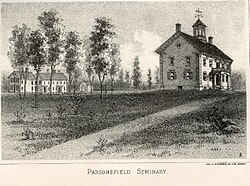Parsonsfield, Maine
This was part of a large tract of land sold on November 28, 1668, by Newichewannock Indian Chief Sunday (or Wesumbe) to Francis Small, a trader from Kittery.
Small then sold half his interest to Major Nicholas Shapleigh of what is now Eliot.
In 1771, heirs sold the township to Thomas Parsons and 39 associates, upon which it was surveyed into 100-acre (0.40 km2) lots.
[3] On August 29, 1785, the town was incorporated as Parsonsfield after Thomas Parsons, one of the largest proprietors.
[4] The surface of the town is rough and hilly, its soil rocky but fertile for farming.
The town's highest point is Wiggin Mountain,[6] 1,300 feet (400 m) above sea level.
It is bordered by Effingham and Wakefield, New Hampshire to the west, Porter and Hiram to the north, Cornish and Limerick to the east, and Newfield to the south.
Note: The following section is largely copied from the book "History of Parsonsfield, Maine: 1771–1888," published by Brown Thurston & Company, 1888.
The town of Parsonsfield is in the extreme northwest corner of York County, Maine.
Effingham and Wakefield, NH, are on the western border, Newfield is on the south, Limerick and Cornish on the east.
The outer lines of the town have been measured several times, giving an area from 62.23 to 64 square miles (161 to 166 km2).
Another tradition goes something like this: "Many years ago a famous hunter, named Randall, hunted hereaway among these mountains and caught much game.
He usually reposed on the top of the high mountain by the rivulet, where it is supposed he was murdered by another hunter for his furs.
The supposed murderer was absent only a few days from the settlements and returned heavily laden with valuable skins."
The high ridge, of which Cedar Mountain is the apex, runs east and west across the town.
The town is dotted all over with hills and swells, some of them hard to climb, but generally productive.
Coarse granite rock projects here and there, but surface ledges cover only a small part of the town.
There are but few swamps or bog meadows, for the reason that the surface is tilted this, that, and every way, but valuable intervales lie along the brooks and rivers.
The original forest growth was maple, beech, hemlock, pine, birch, oak, and ash, with scores of other trees interspersed.
Each variety prevailing in its favored locality, but not holding exclusive possession of a single farm.
That easement will protect Leavitt Plantation in perpetuity, while allowing sustainable forestry practices.
Attended by Reggie Bird (Basketball player), Leonard Nemoy (Star Trek), Louis Kane (former owner of Au Bon Pon) Dan Andelman (host of Phantom Gourmet), Hatchet Harry, musician “Yonas” and musician Jeremy Zucker.

